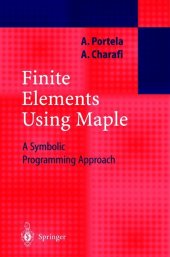 Neuerscheinungen 2012Stand: 2020-01-07 |
Schnellsuche
ISBN/Stichwort/Autor
|
Herderstraße 10
10625 Berlin
Tel.: 030 315 714 16
Fax 030 315 714 14
info@buchspektrum.de |

A. Charafi, Artur Portela
(Beteiligte)
Finite Elements Using Maple
A Symbolic Programming Approach
Softcover reprint of the original 1st ed. 2002. 2012. xv, 326 S. 138 SW-Abb. 235 mm
Verlag/Jahr: SPRINGER, BERLIN 2012
ISBN: 3-642-62755-2 (3642627552)
Neue ISBN: 978-3-642-62755-2 (9783642627552)
Preis und Lieferzeit: Bitte klicken
This text provides the reader with a unique insight into the finite element method, along with symbolic programing that fundamentally changes the way applications can be developed. It is an essential tool for undergraduate or early postgraduate courses as well as an excellent reference book for engineers and scientists who want to quickly develop finite-element programs. The use of symbolic computation in Maple system delivers new benefits in the analysis and understanding of the finite element method.
´1. Introduction to Maple.- 1.1 Basics.- 1.2 Entering Commands.- 1.3 Fundamental Data Types.- 1.4 Mathematical Functions.- 1.5 Names.- 1.6 Basic Types of Maple Objects.- 1.6.1 Sequences.- 1.6.2 Lists.- 1.6.3 Sets.- 1.6.4 Arrays.- 1.6.5 Tables.- 1.6.6 Strings.- 1.7 Evaluation Rules.- 1.7.1 Levels of Evaluation.- 1.7.2 Last-Name Evaluation.- 1.7.3 One-Level Evaluation.- 1.7.4 Special Evaluation Rules.- 1.7.5 Delayed Evaluation.- 1.8 Algebraic Equations.- 1.9 Differentiation and Integration.- 1.10 Solving Differential Equations.- 1.11 Expression Manipulation.- 1.12 Basic Programming Constructs.- 1.13 Functions, Procedures and Modules.- 1.14 Maple´s Organization.- 1.15 Linear Algebra Computations.- 1.16 Graphics.- 1.17 Plotter: Package for Finite Element Graphics.- 1.17.1 Example.- 1.17.2 Example.- 1.17.3 Example.- 2. Computational Mechanics.- 2.1 Introduction.- 2.2 Mathematical Modelling of Physical Systems.- 2.3 Continuous Models.- 2.3.1 Equilibrium.- 2.3.2 Propagation.- 2.3.3 Diffusion.- 2.4 Mathematical Analysis.- 2.5 Approximation Methods.- 2.6 Discrete Models.- 2.7 Structural Models.- 3. Approximation Methods.- 3.1 Introduction.- 3.2 Residuals.- 3.3 Weighted-Residual Equation.- 3.3.1 Example.- 3.4 Approximation Functions.- 3.5 Admissibility Conditions.- 3.5.1 Example.- 3.6 Global Indirect Discretization.- 3.6.1 Satisfaction of Boundary Conditions.- 3.6.2 Domain Methods of Approximation.- 3.6.3 Galerkin Method.- 3.6.4 Least Squares Method.- 3.6.5 Moments Method.- 3.6.6 Collocation Method.- 3.6.7 Example.- 3.6.8 Example.- 3.7 Integration by Parts.- 3.7.1 Strong, Weak and Transposed Forms.- 3.7.2 One-Dimensional Case.- 3.7.3 Example.- 3.7.4 Higher-Dimensional Cases.- 3.7.5 Example.- 3.8 Local Direct Discretization.- 3.8.1 Nodes and Local Regions.- 3.8.2 Satisfaction of Boundary Conditions.- 3.8.3 Finite Difference Method.- 3.8.4 Finite Element Method.- 3.8.5 Boundary Element Method.- 3.8.6 Example.- 3.8.7 Example.- 3.8.8 Example.- 4. Interpolation.- 4.1 Introduction.- 4.2 Globally Defined Functions.- 4.2.1 Polynomial Bases.- 4.2.2 Example.- 4.2.3 Example.- 4.2.4 Conclusions.- 4.3 Piecewisely Defined Functions.- 4.3.1 Spline Interpolation.- 4.3.2 Finite Element Interpolation.- 4.4 Finite Element Generalized Coordinates.- 4.4.1 Convergence Conditions.- 4.4.2 Geometric Isotropy.- 4.4.3 Finite Element Families.- 4.5 Finite Element Shape Functions.- 4.5.1 Natural Coordinates.- 4.5.2 Curvilinear Coordinates.- 4.5.3 Example.- 4.6 Parametric Finite Elements.- 4.7 Isoparametric Finite Elements.- 4.7.1 Convergence Conditions.- 4.7.2 Evaluation of Element Equations.- 4.7.3 Numerical Integration.- 4.8 Linear Triangular Isoparametric Element.- 4.8.1 Example.- 4.8.2 Example.- 4.8.3 Example.- 4.8.4 Example.- 5. The Finite Element Method.- 5.1 Introduction.- 5.2 Steady-State Models with Scalar Variable.- 5.2.1 Continuous Model.- 5.2.2 Weighted Residual Galerkin Approximation.- 5.2.3 Discrete Model.- 5.3 Finite Element Mesh.- 5.3.1 Linear Triangular Isoparametric Element.- 5.3.2 Total Potential Energy.- 5.3.3 Internal Potential Energy Density.- 5.3.4 Mesh Topology.- 5.4 Local Finite Element Equations.- 5.5 Global Finite Element Equations.- 5.6 Exact Boundary Conditions.- 5.7 Solution of the System of Equations.- 5.8 Computation of Derivatives.- 5.9 Finite Element Pre- and Post- Processing.- 5.10 Cgt-fem: Package for Finite Element Analysis.- 5.10.1 Data Preparation.- 5.11 Example.- 5.12 Example.- 5.13 Example.- 5.14 Example.- 6. Fluid Mechanics Applications.- 6.1 Introduction.- 6.2 Continuous Models of Fluid Flow.- 6.2.1 Incompressible Fluids.- 6.2.2 Inviscid Fluids.- 6.2.3 Irrotational Flows.- 6.2.4 Steady-State Flows.- 6.2.5 Bernoulli´s Energy Conservation.- 6.2.6 Velocity Potential.- 6.2.7 Stream Function.- 6.3 Confined Flows.- 6.4 Unconfined Flows.- 6.5 Groundwater Flows.- 6.5.1 Darcy´s Hypothesis.- 6.5.2 Dupuit´s Hypothesis.- 6.6 Example.- 6.


